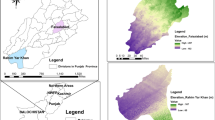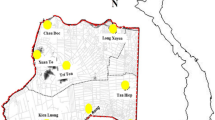Abstract
Irrigation is significant in increasing agriculture production and productivity for the sustainability of the country’s economy. Impacts on existing activities for irrigation design and management systems are obvious due to the rapid change of climate system. This paper’s future focus is to evaluate the influence of the changing climate on the crop yield and irrigation requirement for the Wonji Shoa sugarcane plantation estate. For future climate data, it used the results of projections of the CORDEX regional climate model (RCM) with bias correction for medium concentration representative pathway 4.5 rcp and high concentration representative pathway 8.5 rcp scenario. The down-scaled data were then used as input to the AquaCrop model. The time series indicates a significant increasing trend in maximum and minimum temperature values and a slight increasing trend in precipitation for both 4.5 rcp and 8.5 rcp scenarios. The evapotranspiration shows an increase in 20.34%, 20.12%, 23.59%, and 24.36% for 8.5 rcp in the period of 2020s, 2040s, 2060s, and 2080s, respectively. For 4.5 rcp scenario, the change is about 8.4%, 11.65%, 13.22%, and 15.85% for the period of 2020s, 2040s, 2060s, and 2080s, respectively. The model output shows that there is an annual increase in yield. For 8.5 rcp scenarios, the incensement is 6.2%, 7.84, 11.03%, and 14.48% in the 2020s, 2040s, 2060s, and 2080s, respectively. For 4.5 rcp scenarios, the increment is much lower compared to 8.5 rcp scenarios. But there is still an increase in yield for 4.5 rcp. The change is 0.3%, 1.8%, 7.02%, and 4.82% for the period of 2020s, 2040s, 2060s, and 2080s, respectively.






Similar content being viewed by others
Data Availability
All data generated and analyzed during this study are included in this published article.
References
Jaarraud M, Steiner A (2012) Summary for policymakers
Genanu M (2017) Remote sensing based estimation of evapo-transpiration using selected algorithms: the case of Wonji Shoa Sugar Cane Estate, Ethiopia. Int J Sensors Sens Networks 5(1):1
Degefa S, Saito O (2017) Assessing the impacts of large-scale agro-industrial sugarcane production on biodiversity: a case study of Wonji Shoa Sugar Estate, Ethiopia. Agriculture 7(12)
Zhu X, Troy TJ (2018) Agriculturally relevant climate extremes and their trends in the world’s major growing regions. Earth’s Futur 6(4):656–672
Taylor KE, Stouffer RJ, Meehl GA (2012) An overview of CMIP5 and the experiment design. Bull Am Meteorol Soc 93(4):485–498
Tadese MT, Kumar L, Koech R, Zemadim B (2019) Hydro-climatic variability: a characterisation and trend study of the Awash River Basin, Ethiopia. Hydrology 6(2):3
Sanghera GS, Malhotra PK, Bhatt R (2019) Climate change impact in sugarcane agriculture and mitigation strategies. J Environ Agric Sci 2:99–114
El Chami D, Daccache A, El Moujabber M (2020) What are the impacts of sugarcane production on ecosystem services and human well-being? A review. Ann Agric Sci 65(2):188–199
Ministry of Water Resources and the National Meteorological Services Agency (2001) Initial national communication of Ethiopia to the united nations framework convention on climate change. AJEC, pp 1–113
Mascaro G, Viola F, Deidda R (2018) Evaluation of precipitation from EURO-CORDEX regional climate simulations in a small-scale Mediterranean site. J Geophys Res Atmos 123(3):1604–1625
Navarro-Racines, Tarapues-Montenegro, J. E. and Ramírez-Villegas, and Ramírez-Villegas, “Bias-correction in the CCAFS-climate portal: a description of mehotodologies. How to cite this document?,” Decis Policy Anal Res Area, 2015.
Acknowledgements
The research was implemented under a collaborative partnership with the Addis Ababa University so the authors would like to thank these organizations for the financial and other support during this work. We also acknowledge the anonymous reviewers, whose comments greatly improved the paper.
Author information
Authors and Affiliations
Contributions
B.A. conceived and developed the research framework. T.D., M.A, and S.E undertook the data processing and analysis. T.D., B.A., and S.E. wrote and revised the manuscript. G.M. supervised and revised the manuscript. All authors have read and agreed to the published version of the manuscript.
Corresponding author
Ethics declarations
Competing Interests
The authors declare no competing interests.
Additional information
Publisher’s Note
Springer Nature remains neutral with regard to jurisdictional claims in published maps and institutional affiliations.
Rights and permissions
Springer Nature or its licensor (e.g. a society or other partner) holds exclusive rights to this article under a publishing agreement with the author(s) or other rightsholder(s); author self-archiving of the accepted manuscript version of this article is solely governed by the terms of such publishing agreement and applicable law.
About this article
Cite this article
Abera, B., Desale, T., Asmare, M. et al. Impact of Climate Change on Irrigation Case Study on Wonji Shoa Sugar Plantation Estate. Water Conserv Sci Eng 9, 5 (2024). https://doi.org/10.1007/s41101-024-00237-z
Received:
Revised:
Accepted:
Published:
DOI: https://doi.org/10.1007/s41101-024-00237-z




